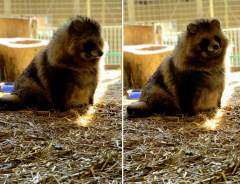- Tags:
- Nasu Animal Kingdom / sand cat / Zoo
Related Article
-

Tanuki’s Reaction to Overturning Her Bowl is Relatable to Anyone Who’s Ever Dropped Food
-

It’s Love At First Sight For This Penguin And A Cardboard Panel Of A Kawaii Kemono Friends Character
-

Do tanuki really transform when you put a leaf on their head? Zoo in Japan puts the rumor to the test!
-

“I’m so over today” Hyena in Japanese zoo has the most relatable zoned out look
-

This Little Red Panda Loves His Caretaker A Little Too Much. What A Baby!
-

This Japanese Raccoon Has The Cutest Way Of Asking For Food



Nasu Animal Kingdom zoo in Tochigi Prefecture recently welcomed a new member to their family: a female kitten sand cat. The cat, still to be named, was born in late April and has been growing strong under the care of zookeepers.
The kitten greets zoo-goers during uncertain times—the Nasu Animal Kingdom zoo just reopened following the coronavirus state of emergency and lockdown. Upon birth, she weighed in at 59 grams and measured 13 cm from head to tail. While she was weak early on, she has dramatically increased in size and weight. Currently, she is can be seen on a limited schedule.
Sand Cats
Sand Cats, as their name suggests, are found in deserts throughout the world. Measuring about 40 to 60 cm in length, they are one of the smallest wildcats in the world.
Sand cats are most active at night and, living in scarcely populated deserts, will travel great lengths daily searching for food. They have evolved to live without drinking water, rather absorbing moisture from the food they eat.
Deserts, scorchingly hot during the day and frigid at night, are obviously harsh environments to call home. Yet, sand cats are well adapted. They have insulating light brown fur that camouflages them with their surroundings. Fur also covers the pads on the bottom of their feet, allowing them to walk on the blistering hot sand. This fur also prevents them from leaving tracks, which could be followed by predators.
Sand cats live at very low densities, and neighboring cats may live kilometers away. While searching at night, the felines emit a kind of barking. Their large ears are well adapted at detecting these sounds, and thereby help them draw together. If they should successfully mate, they have small litters of two or three kittens
Videos
Fortunately for us all, the Nasu Animal Kingdom zoo has been releasing footage of their new kitten on YouTube. And it only takes a microsecond to realize what all the excitement is about—sand cat kittens are incredibly adorable, even if a little shaky.
The short video shows the young kitten afters she has become somewhat strong and healthy. You can see her moving about in her home and her parents awaiting the child to come home to join them. Nevertheless, the wide-eyes of the young kitten are most striking.
The zoo is also releasing a weekly diary video series featuring the kitten. They are a bit longer and provide a more detailed view of the sand cat and its early experiences.
As you can see, she was born a bit small and a bit weak. As such, she relied heavily on human care throughout this early period. She took several feedings per day and had yet to open either eye at this point.
At nine days, she is a bit more active but obviously weak and shaky. A lot of precaution is necessary while caring for her to make sure she does not become sick or infected. Nevertheless, she has received a lot of attention and support on social media. With her popularity growing, hopefully, she can help educate people about sand cats as she is introduced to the world.
As you might expect, viewers were struck by the young feline.